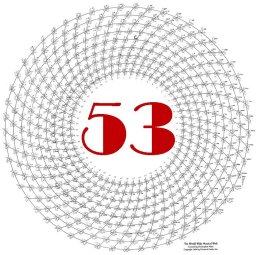Next Page: 2/5 – Ancient Greece; Cents
Beginning to Create a Lattice of Tonal Relationships
Music is the soul of geometry. –Paul Claudel
Ancient China, Greece and the early Catholic Church all derived their modes from the 2nd and 3rd harmonics only (octaves such as C-C, fifths up such as C-G and fifths down such as C-F, which are perfect fourths). There is a certain simplicity to this approach, but it quickly creates almost unsingable harmonic complexity, as we shall soon see. It’s easy to create a harmonic map of any three-limit scale: simply draw a horizontal line and on that line, list your perfect fifths left and right from C:
Eb (32/27) — Bb (16/9) — F (4/3) — C (1/1) — G (3/2) — D (9/8) – A (27/16) — E (81/64) — B (243/128)
Notice how pure, beatless and resonant is the sound of these perfect fifths. You most assuredly are not the first to discover this: from the ancient Chinese to Pythagoras to the Gregorian Catholics to the Arabs, the crystalline clarity of that sound inspired them to reject all other higher harmonics as sloppy and dissonant by comparison!
Still, there are many ancient cultures which accepted as “consonant” or instinctively sang the relationships created by the fifth harmonic (the major third). To diagram these harmonic relationships, we must add a second dimension. And here is where we also need to find ways to improve our letter-based notation, because in “five-limit” scales, the third and fifth harmonics are both allowed, and they create different harmonic relationships and different pitches. In the 19th century, Hermann Helmholtz, in his groundbreaking book On the Sensations of Tone (with extensive later revisions, additions and English translation by Alexander J. Ellis), developed a system of superscripts and subscripts to more accurately notate 5-limit scales and their tunings.
First, we have to add a second dimension to our chart. From C, if we traverse a vertical ladder of major thirds, it would look like this:
|
E1 (5/4)
|
C (1/1)
|
A1b (8/5)
|
F2b (32/25)
If you go up a major third, you end up on a note we call E. Notice how, on the horizontal plane of 3-limit relationships, you also find an E four fifths up from C. But the 3-limit E is about a seventh of a half-step higher than the 5-limit E1 on the vertical ladder (above). This also means that if you play the 3-limit E preferred by the ancient Chinese, the harmonic ratio is 81/64, whose high numbers create a complexity the ear has a hard time hearing. The voice also prefers to sing in tune with the simpler ratios, which are not only easier to hear but easier to reproduce. This means that Ling Lun’s mathematically “pure” 3-limit pipes conflicted with the natural tendencies of the human ear and voice, which gravitate towards the much simpler 5-limit ratio of E1 (5/4). As it happens, the 3-limit E is only 1/12th of a half-step higher than the 12-equal E we hear on the piano, but the mellower and lower 5-limit E1 is more like a sixth of a half step lower than the E on a piano. Here is what they sound like, first the Pythagorean vs. the just third, then the vertical line of thirds, diagrammed above:
Not as pretty as the fifths, are they? That’s because F2b and E1 are pretty dissonant and only about an octave apart (they play the same on a regular piano, but as we will see, they most definitely are not the same note!). Same with the A1b and the G2#….
If you would like to learn more about this chapter, “Beginning to Create a Lattice of Tonal Relationships,” which includes the World Wide Musical Web in a large enough format for you to see every detail of the entire musical mandala, you can buy the entire book, The Grand Unified Theory of Music, in pdf form for $25 with hundreds of embedded musical examples of scales and chords from all over the world.
A free introduction to what The Grand Unified Theory of Music offers is on this website and includes both text and a few musical examples from each webpage. If you would like to learn more about this chapter and the full contents of this entire e-book, you can buy The Grand Unified Theory of Music for $25, with hundreds of embedded musical examples of scales and chords from all over the world — and ideas for how to set up your computer system —
HERE.
You’ll get a personalized password you can use to see the entire e-book. Inside the full book, you will also get a link to the complete pdf file of this e-book, which you can read on your Kindle or similar device. The links to the hundreds of mp3 sound files – the same ones you can hear on the website — will also be included. This is “Version 1.0” of The Grand Unified Theory of Music. Because it is an e-book, additions, corrections and improvements in the sound may be added at any time. The Grand Unified Theory of Music is Copyright © 2018 by Christopher Mohr. All rights reserved.
One person per password. Sharing this password with others is a violation of copyright. Do not allow others to use your password or link to the pdf file!
